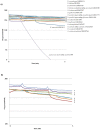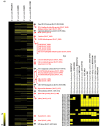Bifidobacterium asteroides PRL2011 genome analysis reveals clues for colonization of the insect gut
- PMID: 23028506
- PMCID: PMC3447821
- DOI: 10.1371/journal.pone.0044229
Bifidobacterium asteroides PRL2011 genome analysis reveals clues for colonization of the insect gut
Abstract
Bifidobacteria are known as anaerobic/microaerophilic and fermentative microorganisms, which commonly inhabit the gastrointestinal tract of various animals and insects. Analysis of the 2,167,301 bp genome of Bifidobacterium asteroides PRL2011, a strain isolated from the hindgut of Apis mellifera var. ligustica, commonly known as the honey bee, revealed its predicted capability for respiratory metabolism. Conservation of the latter gene clusters in various B. asteroides strains enforces the notion that respiration is a common metabolic feature of this ancient bifidobacterial species, which has been lost in currently known mammal-derived Bifidobacterium species. In fact, phylogenomic based analyses suggested an ancient origin of B. asteroides and indicates it as an ancestor of the genus Bifidobacterium. Furthermore, the B. asteroides PRL2011 genome encodes various enzymes for coping with toxic products that arise as a result of oxygen-mediated respiration.
Conflict of interest statement
Figures





References
-
- Macfarlane S, Bahrami B, Macfarlane GT (2011) Mucosal biofilm communities in the human intestinal tract. Adv Appl Microbiol 75: 111–143. - PubMed
-
- Hooper LV, Gordon JI (2001) Commensal host-bacterial relationships in the gut. Science 292: 1115–1118. - PubMed
-
- Ouwehand AC, Salminen S, Isolauri E (2002) Probiotics: an overview of beneficial effects. Antonie Van Leeuwenhoek 82: 279–289. - PubMed
-
- Guarner F, Malagelada JR (2003) Gut flora in health and disease. Lancet 361: 512–519. - PubMed
Publication types
MeSH terms
Substances
LinkOut - more resources
Full Text Sources
Molecular Biology Databases

